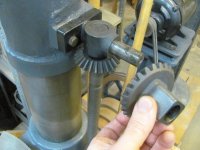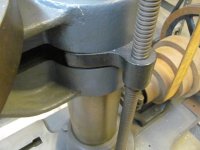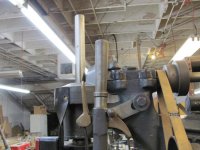Here's the pictures of my Royersford 21. It's the same machine as yours, except it has the extended base with the motor mount built in. Yours would have the same yoke & countershaft assembly bolted to the base. In place of the large double V belt pulley would be a pair of fast/loose flat belt pulleys, about 7" dia x 2 1/2" wide. Those would be driven by a belt from the overhead lineshaft. So, if you plan to run yours from an electric motor, you'll need to rig up something similar to what's on mine. You'll need a lower countershaft with a stepped cone pulley to match the upper one, and then drive that at about a 1:6 ratio from a 1750 rpm 1 hp motor. If you can't find a suitable cone pulley somewhere, you can make one up from steel, cast iron, or even laminated hardwood.
The table elevating parts also shouldn't be too hard to fabricate. The vertical threaded shaft is 1" diameter with a square thread, but you could make up a replacement from 1" ACME threaded rod. The bottom end is turned to a tip that rides in the little cup in the base casting. The upper end is pinned to the bevel gear. The gears are 3" diameter with a 1" bore.
The quill is (supposed to be) counterbalanced by a big iron weight that hangs down inside the column. A small roller chain attaches to the clamp ring on the quill, and runs over two pulleys, down into the hollow center. You may have some fun fishing that counterweight up from inside the column and attaching it to the chain through the slot in the back of the column. You can see the second pulley inside the slot.
I notice that the tip of the long handle on yours looks like it's been cut off? I wonder why? Maybe someone got smacked in the head when the counterweight chain broke, and cut it off in revenge!























